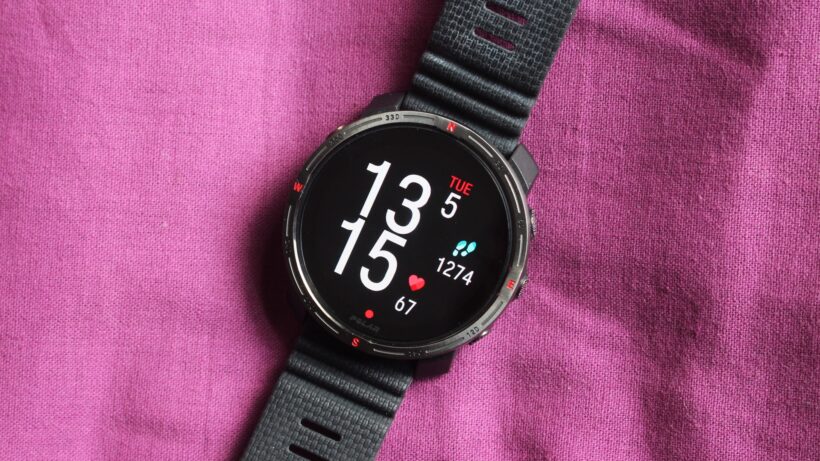Polar delivers a neat, more affordable choice to its outdoor range
The Grit X2 might not be a headline-grabbing, innovative leap forward, but it’s a shrewd release that fills a gap in the Polar lineup. By distilling the core, high-end features of the X2 Pro—like the Elixir sensor, dual-frequency GPS, and solid mapping—into a lighter, smaller, and more affordable package, Polar has created a compelling proposition. It trades the premium materials of its sibling, but the drop in price and more manageable size will be a welcome trade-off for many. If you’ve been tempted by Polar’s offerings but put off by the flagship price tag and bulk, the Grit X2 is the pragmatic and, for most people, the smarter choice.
Pros
- Same software and hardware as the Grit X2 Pro
- Good mapping and navigation support
- Refined outdoor watch style
Cons
- Not top-tier outdoor watch battery
- Polar Flow app isn't super intuitive
- No new smartwatch features
The Polar Grit X family has become a crowded one. In the five years since the original launched, the Finnish company has expanded its outdoor watch lineup considerably. But with ‘Pro’ and ‘Titan’ monikers already attached to higher-priced releases, where does the new Grit X2 fit in?
Well, think of this as a stripped-back version of the excellent Polar Grit X2 Pro we tested last year. The mission here is simple: take the top-tier features from its sibling—including the headline-grabbing Elixir biosensor tech, crucial dual-frequency GPS for accuracy, and a vibrant AMOLED display for mapping—and package them in a more affordable build.
This positions the Grit X2 in an interesting sweet spot. It offers a compelling alternative for outdoor watch fans who might be eyeing up a Garmin Fenix 8 (or the older Fenix 7 Pro), waiting for the Apple Watch Ultra 3, or going left-field with the Coros Vertix 2S, but are hesitant to part with that top-tier cash.
We were big fans of the Grit X2 Pro’s performance. So, on paper, the standard X2 should be a surefire hit. But does stripping back the premium materials impact the experience, and has Polar successfully carved out a space for a high-end outdoor watch that isn’t quite a flagship? We’ve been putting it to the test to find out.
Price and competition
Starting with pricing, which is an interesting point. In the US, the Grit X2 still doesn’t have a release date (and therefore official pricing. If you want it in the US, you’ll need to purchase it from another region where it’s available. In the UK, the price is £399. In Europe, it’s €479.90. Converted, that puts the Grit X2 at around $500-$550.
This makes it a significantly more affordable option than the X2 Pro (£699/€749.90), and lumps it into a similar category as watches like the Garmin Instinct 3, Garmin Forerunner 570, Suunto Race, and Coros Pace Pro.
The Instinct 3 is the only outdoor-focused watch among the alternatives. Yet, unlike the X2, it doesn’t offer complete mapping support.
Design and display

The Grit X2 is an outdoor watch that doesn’t scream its presence. It features a 44mm case available in brown or black colors. This case size gives it a similar stature to Garmin’s 45mm Instinct 3. It features a sharp 1.28-inch, 416 x 416 AMOLED display that can stay on continuously. The display is also complemented by five textured buttons around the screen, which are easy to press even when your fingers are wet or sweaty from the weather and workouts.
It’s also protected by sapphire glass, offering durable scratch resistance, and the stainless steel bezel is subtle. It doesn’t overpower the design as it so often does on other outdoor watches. That ensures it’s one we feel comfortable describing as a refined outdoor smartwatch.

The strap, while flexible, feels quite stiff. If it’s snug, you definitely notice it. The strap can be removed easily using a simple, familiar sliding pin mechanism.
In terms of what you’re missing out on compared to the Pro version, this standard edition doesn’t include the larger 49mm case or bigger and higher-resolution AMOLED display. The stainless steel case of the Pro is replaced with a plastic equivalent here, too, while the costlier model also has a higher waterproof rating (100 meters vs. 50 meters on the Grit X2).
Some will undoubtedly prefer the lighter, thinner, and more manageable size of the X2. Overall, it’s an attractive alternative to the flagship and a design that we found perfectly comfortable in daily use, for sleep tracking, and during running workouts.
Smartwatch features

If you’re seeking a balance of outdoor, sports, and smartwatch features, the Grit X2 may not be the top option. Polar continues to play catch-up by adding more smartwatch functionalities, and that means it still lags behind the likes of Garmin (a brand that itself can’t match up to ‘proper’ smartwatches from Apple and Samsung).
For example, the Grit X2 will display yoru phone notifications, you just won’t be able to act on them. There are some nice weather widgets, such as one that incorporates hourly forecasts into the watch face shown above. And you also have music controls here, which can be accessed during workouts and when you’re not in tracking mode. But it’s all a relatively barebones experience.

Ultimately, the controls are well implemented. And, like the notification support, it’s not offering anything new or groundbreaking for that support.
So, if you’re happy with notifications and music controls (and we imagine many absolutely will), then the Grit X2 has got you covered—just don’t expect the kind of support found on the Apple Watch app library or Garmin Connect IQ.
Battery life

A single or two days of battery life isn’t enough when you’re planning to spend days exploring or running nonstop. Thankfully, the Grit X2 lasts a fair bit longer than that. Polar states that the 310mAh capacity battery can last up to a week (though this assumes you don’t enable the always-on display).
If you choose the AOD setting, the battery life will naturally be much shorter—but our testing can support the initial claim by Polar; it’s a watch that will comfortably last through seven days. This is to be expected, given that there are few features that consume power during the day outside of utilizing the watch’s outdoor tracking capabilities.
Yet, even the comprehensive sleep tracking and insights don’t drain the battery as much as on previous Polar watches, so we still think the Grit X2 offers decent battery life—even if it also falls somewhat short of the 10-day estimate of the Pro model.

How the Grit X2’s battery life compares
When tracking and using the GPS, you’ll get up to 30 hours of battery life in the best GPS accuracy mode. Extending this to 90 hours is possible by using Polar’s ‘Eco’ training mode, which turns off heart rate tracking, the always-on display, and switches to single-frequency GPS mode.
For context, a 45mm Garmin Instinct 3 lasts up to 23 hours in its best GPS accuracy mode and can extend to 16 days in its comparable ‘Expedition’ GPS mode. Those top GPS accuracy figures are comparable to the competition and probably sufficient for most trackers, but there are certainly outdoor watches available that last longer.
One interesting battery-focused feature Polar has added is the ability to charge the watch while you’re tracking. This is obviously a tricky one if you’re going for a run or engaging in similar vigorous activity. However, if you’re hiking or walking, it’s a neat trick to be able to plug it into a power bank while still on the move and avoid missing out on distance metrics or navigation.
Outdoor features: Mapping and navigation

Like other Grit watches, the X2 is primarily an outdoor watch. And the good news is that you’re not missing out on anything from the pricier Grit X2 Pro in terms of features and insights.
This means it comes with complete mapping support and 32GB of storage for map data. Downloading these maps to the watch involved the Polar Flow web platform by dragging and dropping folders, since the brand is phasing out the FlowSync desktop app.
It’s undoubtedly still a fiddly process, and can also take much longer if you opt for the more detailed mapping option. However, once done, you’ll be able to view maps from the navigation watch widget, where you can also conveniently switch between the available maps and see how much space they’re occupying.

The maps feature detailed design, and are compatible with both buttons and touchscreen for navigation. Moving to another map section is also responsive, allowing you to view points of interest and change the map orientation as needed without latency.
Turn-by-turn navigation is available only when you upload routes, whether through a GPX file or via third-party apps like Komoot or Strava Routes. For the latter options, you will, of course, need to be a paid subscriber.
If you can live with breadcrumb-style trails, that feature is still available, along with a back-to-start mode. However, like other Polar watches with similar mapping functions, you might need to calibrate the compass by moving your wrist in various directions to ensure it points correctly.
Sports tracking

When you want to track runs, rides, circuit training, or a swim, the Grit X2 has you covered. For outdoor workouts, it features the brand’s latest interpretation of its dual-frequency GPS tracking, which is quietly becoming the standard for most smartwatches and sports watches.

As we always point out in our reviews, the presence of dual-frequency GPS doesn’t automatically result in better accuracy than the standard, single-frequency tracking from gold-standard brands like Apple and Garmin. It’s not always a slam-dunk.
However, with that said, we’d put the Grit X2 in the bracket of solid-performing dual-band GPS. We’ve been using it against our typical benchmark, the Garmin Forerunner 970, and the X2 has performed well overall.

We’ve also used it for pool swims, on the indoor bike, and switched to the general indoor mode to track workouts without available profiles, and the X2’s heart rate monitoring is equally solid.
As is typical from what we’ve come to expect from the brand’s Elixir optical sensor (which brings ECG measurements as well as SpO2 and skin temperature tracking), it’s a good performer without really threatening the best wrist-based options.
It’s been fine for steady-tendspaced workouts. However, when it’s time to up the intensity, it still tends to report higher average and maximum readings. Again, as we always say, if you want tip-top accuracy in all workout types, pair it with an external chest strap heart rate monitor.
Sleep tracking and training insights

One of Polar’s strengths is the insights it can provide if you’re serious about optimizing your training and recovery time.
There’s plenty here, including Polar’s useful Training Load Pro and Cardio load insights, FuelWise fueling reminders, as well as FitSpark providing recommended workouts based on your workout history. You’re also gaining access to Polar’s latest performance tests, including its leg recovery and walking tests.

Insights and training features are well-displayed on the watch, but exploring them on the Polar Flow app can often prove chaotic and complicated due to the lack of organization. Polar isn’t the only brand to fall foul of this issue—but, if you’re new to the Polar ecosystem, it might not be the most intuitive experience.
In the wearables industry, Polar was among the pioneers in emphasizing the link between sleep and recovery. And it remains a significant feature in devices like the Grit X2. In addition to the basic sleep statistics most watches now track, it assesses your nightly recharge to help decide if you should train. It also analyzes how sleep impacts your energy levels and separately monitors skin temperature to identify trends over a week or month.

We’ve been using it alongside other sleep trackers, such as the Oura Ring 4 and Ultrahuman Ring Air, to gather data on sleep duration, sleep scores, and to recognize the times we fell asleep and woke up.
How the tracking and analysis compares
The X2 posted similar data overall, and is definitely one that you can trust to grasp the broad trend of how you’re sleeping. A closer look at information like time in REM sleep showed that the data varied from being quite short to aligning with those of other trackers. However, with the Grit X2 and any wrist-based sleep tracker, take elements like stages analysis with a pinch of salt; even the best estimates are some way off being reliable enough to really glean much from.

In the Polar Flow app, nightly recharge measurements and sleep boost insights are displayed separately. However, the Grit X2 has dedicated widgets for both available directly on the watch. The Grit X2’s sleep data also triggers a ‘sleep gate’, encouraging you to sleep during a specific window.
It works well and is similar to what you’d find from brands like Garmin and Whoop. However, although the recharge feature provides valuable data, its presentation and wording could be simplified for easier quick glances.





